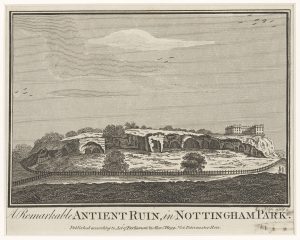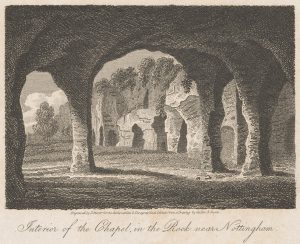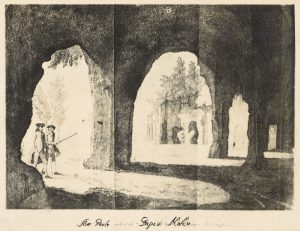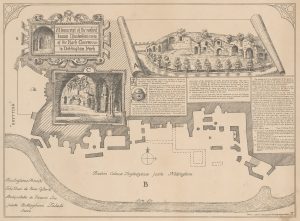November 26, 2024, by Chloe
Rambling around rock holes
William Parsons was a solicitor who lived between around 1809 and 1881, and who, between his legal work, his participation in the political and civic life of Nottingham and his often-rambunctious social life, was witness to major transformations to the fabric of the city due to increasing urbanisation and enclosure – a change to which even the caves were not immune…

Engraved illustration of Nottingham Castle atop Castle Rock, with cutaway showing the caves; undated; postcard 42 from ‘Album of prints depicting Nottingham and Nottinghamshire’
Fortunately for us, he left us a vivid account of those experiences in his diary, which he kept intermittently between 1830 and 1871. In one particularly striking passage from January 28th, 1844, Parsons describes going for stroll and seeing ‘the new allotments marked out for Gardens which will exclude one of the prettiest portions of the open Park from the public, including the Rock Holes or Papist Holes’. The structures he is referring to here are generally known today as Lenton Hermitage. There isn’t any solid evidence for their use as so-called ‘Papist Holes’, more commonly known as priest holes – places for members of the Catholic clergy to hide from the authorities in the post-Reformation period. However, these caves certainly do have religious connections: the involvement with – and even possible habitation of – the chapel site by monks from Lenton Abbey is well-attested.

Engraved illustration of the ‘Rock Chapel’ in the Park by J. Storer; from an ‘Album of prints depicting Nottingham and Nottinghamshire’.
Parsons goes on to relate his own memories of exploring the rock holes during his childhood back in the Regency era, describing them as ‘consecrated in the memories of every schoolboy of the town, in whose maturer minds feelings of regret cannot but arise at their enclosure from the sports and pastimes of the unborn lads in times to come.’ This might may seem like an innocuously sentimental observation, but it becomes quite bizarre considering that Parsons, who by this time had been a city councillor for over a decade, was originally motivated to run for office due to his support for the policy of enclosure, which he appears to be decrying here.

Image of men looking at caves in the Park; postcard 41a from ‘Album of view-postcards, chiefly of Nottingham’; undated. University of Nottingham EMSC Oversize Not 1.D14 ALB
Perhaps this incongruent stroll down memory lane was brought on by the fact that he was accompanied on his walk by his son Fred, who would have been around eight at the time, and therefore would have been one of the first generation of children deprived of that particular pleasure. Regardless of whether or not Parsons was experiencing buyer’s remorse, his interweaving of history and myth into his own nostalgic memories of the Hermitage site, along with his sadness that it will no longer be publicly accessible, demonstrates how large they loomed in the local imagination.

Print of a drawing by T.C. Hine made from an earlier drawing by William Stukeley, showing the caves in Nottingham Park; 1892. University of Nottingham NPE X 3/1
If you’d like to check out this memorable passage in Parsons’ diary for yourself, or find out more about the caves, why not check out our current exhibition, ‘Tales from the Caves’, which is running in the Weston Gallery at Lakeside Arts, Nottingham until 9 March 2025? Find out more on our website!
No comments yet, fill out a comment to be the first

Leave a Reply